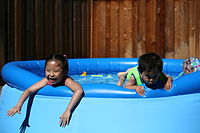Swimming pool
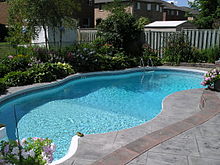

A swimming pool, swimming bath, wading pool, paddling pool, or simply pool, is a structure designed to hold water to enable
Many
History
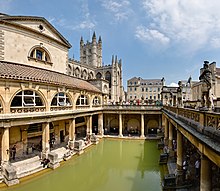
Pre-modern
The "
Ancient Greeks and Romans built artificial pools for athletic training in the palaestras, for nautical games and for military exercises. Roman emperors had private swimming pools in which fish were also kept, hence one of the Latin words for a pool was piscina. The first heated swimming pool was built by Gaius Maecenas in his gardens on the Esquiline Hill of Rome, likely sometime between 38 and 8 BC.[2] Gaius Maecenas was a wealthy imperial advisor to Augustus and considered one of the first patrons of arts.[3]
Ancient Sinhalese built a pair of pools called "Kuttam Pokuna" in the kingdom of Anuradhapura, Sri Lanka, in the 6th century AD. They were decorated with flights of steps, punkalas or pots of abundance, and scroll design.[4][5]
19th century
Swimming pools became popular in Britain in the mid-19th century. As early as 1837, six indoor pools with diving boards existed in London, England.[6] The Maidstone Swimming Club in Maidstone, Kent is believed to be the oldest surviving swimming club in Britain. It was formed in 1844, in response to concerns over drownings in the River Medway, especially since would-be rescuers would often drown because they themselves could not swim to safety. The club used to swim in the River Medway, and would hold races, diving competitions and water polo matches. The South East Gazette July 1844 reported an aquatic breakfast party: coffee and biscuits were served on a floating raft in the river. The coffee was kept hot over a fire; club members had to tread water and drink coffee at the same time. The last swimmers managed to overturn the raft, to the amusement of 150 spectators.[7]
The
The modern Olympic Games started in 1896 and included swimming races, after which the popularity of swimming pools began to spread. In the US, the Racquet Club of Philadelphia clubhouse (1907) boasts one of the world's first modern above-ground swimming pools. The first swimming pool to go to sea on an ocean liner was installed on the White Star Line's Adriatic in 1906.[9] The oldest known public swimming pool in the U.S., Underwood Pool, is located in Belmont, Massachusetts.[10]

Interest in competitive swimming grew following World War I. Standards improved and training became essential. Home swimming pools became popular in the United States after World War II and the publicity given to swimming sports by Hollywood films such as Esther Williams' Million Dollar Mermaid made a home pool a desirable status symbol. More than 50 years later, the home or residential swimming pool is a common sight. Some small nations enjoy a thriving swimming pool industry (e.g., New Zealand pop. 4,116,900 – holds the record in pools per capita with 65,000 home swimming pools and 125,000 spa pools).[12]
A two-storey, white concrete swimming pool building composed of horizontal cubic volumes built in 1959 at the Royal Roads Military College is on the Registry of Historic Places of Canada.[13]
World records

According to the Guinness World Records, the largest swimming pool in the world is San Alfonso del Mar Seawater pool in Algarrobo, Chile. It is 1,013 m (3,323 ft) long and has an area of 8 ha (20 acres). At its deepest, it is 3.5 m (11 ft) deep.[14] It was completed in December 2006.[15]
The largest indoor
In 2021,
The Fleishhacker Pool in San Francisco was the largest heated outdoor swimming pool in the United States. Opened on 23 April 1925, it measured 1,000 by 150 ft (300 by 50 m) and was so large that the lifeguards required kayaks for patrol. It was closed in 1971 due to low patronage.[21]
In Europe, the largest swimming pool opened in 1934 in Elbląg (Poland), providing a water area of 33,500 square metres (361,000 sq ft).[22]
One of the largest swimming pools ever built was reputedly created in
The highest swimming pool is believed to be in Yangbajain (Tibet, China). This resort is located at 4,200 m (13,800 ft) AMSL and has two indoor swimming pools and one outdoor swimming pool, all filled with water from hot springs.[24]
Dimensions
- See: Competition pools (below)

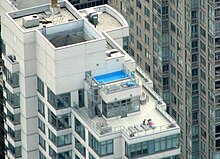
Length: Most pools in the world are measured in metres, but in the United States pools are often measured in feet and yards. In the UK most pools are calibrated in metres, but older pools measured in yards still exist. In the US, pools tend to either be 25 yards (SCY-
USA Swimming (USA-S) swims in both metric and non-metric pools. However, the international standard is metres, and world records are only recognized when swum in 50 m pools (or 25 m for short course) but 25-yard pools are very common in the US. In general, the shorter the pool, the faster the time for the same distance, since the swimmer gains speed from pushing off the wall after each turn at the end of the pool.
Width: The width of the pool depends on the number of swimming lanes and the width of each individual lane. In an Olympic swimming pool each lane is 2.5 meters wide[25] and contains 10 lanes, thus making the pool 25 meters wide.
Depth: The depth of a swimming pool depends on the purpose of the pool, and whether it is open to the public or strictly for private use. If it is a private casual, relaxing pool, it may go from 1.0 to 2.0 m (3.3 to 6.6 ft) deep. If it is a public pool designed for diving, it may slope from 3.0 to 5.5 m (10 to 18 ft) in the deep end. A children's play pool may be from 0.3 to 1.2 m (1 to 4 ft) deep. Most public pools have differing depths to accommodate different swimmer requirements. In many jurisdictions, it is a requirement to show the water depth with clearly marked depths affixed to the pool walls.[citation needed]
Types
Pools can be either indoors or outdoors. They can be of any size and shape, and inground or above ground. Most pools are permanent fixtures, while others are temporary, collapsible structures.
Private pools

Private pools are usually smaller than public pools, on average 3.7 m × 7.3 m (12 ft × 24 ft) to 6.1 m × 12.2 m (20 ft × 40 ft) whereas public pools usually start at 20 m (66 ft).[citation needed] Home pools can be permanently built-in, or be assembled above ground and disassembled after summer. Privately owned outdoor pools in backyards or gardens started to proliferate in the 1950s in regions with warm summer climates, particularly in the United States with desegregation.[26] A plunge pool is a smaller, permanently installed swimming pool, with a maximum size of approximately 3 m × 6 m (10 ft × 20 ft).[27]
Construction methods for private pools vary greatly. The main types of in-ground pools are gunite shotcrete, concrete, vinyl-lined, and one-piece fiberglass shells.
Many countries now have strict pool fencing requirements for private swimming pools, which require pool areas to be isolated so that unauthorized children younger than six years cannot enter. Many countries require a similar level of protection for the children residing in or visiting the house, although many pool owners prefer the visual aspect of the pool in close proximity to their living areas, and will not provide this level of protection. There is no consensus between states or countries on the requirements to fence private swimming pools, and in many places they are not required at all, particularly in rural settings.[28]
Children's pools
Inexpensive temporary polyvinyl chloride pools can be bought in supermarkets and taken down after summer. They are used mostly outdoors in yards, are typically shallow, and often their sides are inflated with air to stay rigid. When finished, the water and air can be let out and this type of pool can be folded up for convenient storage. They are regarded in the swimming pool industry as "splasher" pools intended for cooling off and amusing toddlers and children, not for swimming, hence the alternate name of "kiddie" pools.[citation needed]
Toys are available for children and other people to play with in pool water. They are often blown up with air so they are soft but still reasonably rugged, and can float in water.
-
A black Labrador Retriever bathing in a kiddie pool
-
Children playing in an inflatable pool
Public pools

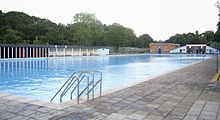
Public pools are often part of a larger
Many upscale hotels and holiday resorts have a swimming pool for use by their guests. If a pool is in a separate building, the building may be called a
Many public swimming pools are rectangles 25 m or 50 m long, but they can be any size and shape. There are also elaborate pools with artificial waterfalls, fountains, splash pads, wave machines, varying depths of water, bridges, and island bars.

Some swimming facilities have lockers for clothing and other belongings. The lockers can require a coin to be inserted in a slot, either as deposit or payment. There are usually showers – sometimes mandatory – before and/or after swimming. There are often also lifeguards to ensure the safety of users.
Wading or paddling pools are shallow bodies of water intended for use by small children, usually in parks. Concrete wading pools come in many shapes, traditionally rectangle, square or circle. Some are filled and drained daily due to lack of a filter system. Staff chlorinate the water to ensure health and safety standards.[citation needed]
Competition pools
- See: #Dimensions (above) and Swimming (sport)#Competition pools

The
An Olympic-size swimming pool (first used at the 1924 Olympics) is a pool that meets FINA's additional standards for the Olympic Games and for world championship events. It must be 50 by 25 m (164 by 82 ft) wide, divided into eight lanes of 2.5 m (8.2 ft) each, plus two areas of 2.5 m (8.2 ft) at each side of the pool. Depth must be at least 2 m (6.6 ft).[29]
The water must be kept at 25–28 °C (77–82 °F) and the lighting level at greater than 1500 lux. There are also regulations for color of lane rope, positioning of backstroke flags (5 metres from each wall), and so on.[29] Pools claimed to be "Olympic pools" do not always meet these regulations, as FINA cannot police use of the term. Touchpads are mounted on both walls for long course meets and each end for short course.
A pool may be referred to as fast or slow, depending on its physical layout.[30] Some design considerations allow the reduction of swimming resistance making the pool faster: namely, proper pool depth, elimination of currents, increased lane width, energy absorbing racing lane lines and gutters, and the use of other innovative hydraulic, acoustic and illumination designs.

Exercise pools
In the last two decades, a new style of pool has gained popularity. These consist of a small vessel (usually about 2.5 × 5 m) in which the swimmer swims in place, either against the push of an artificially generated water current or against the pull of restraining devices. These pools have several names, such as swim spas, swimming machines, or swim systems. They are all examples of different modes of resistance swimming.
Hot tubs and spa pools

Hot tubs and spa pools are common heated pools used for relaxation and sometimes for therapy. Commercial spas are common in the swimming pool area or sauna area of a

Home spas are a worldwide retail item in western countries since the 1980s, and are sold in dedicated spa stores, pool shops,
Whirlpool tubs first became popular in the U.S. during the 1960s and 1970s. A spa is also called a "jacuzzi" there, as the word became a generic after-plumbing component manufacturer;
Ocean pools

In the early 20th century, especially in Australia, ocean pools were built, typically on headlands by enclosing part of the rock shelf, with water circulated through the pools by flooding from tidal tanks or by regular flooding over the side of the pools at high tide. This continued a pre-European tradition of bathing in rockpools with many of the current sites being expanded from sites used by Aboriginal Australians or early European settlers. Bathing in these pools provided security against both rough surf and sea life. There were often separate pools for women and men, or the pool was open to the sexes at different times with a break for bathers to climb in without fear of observation by the other sex.[31] These were the forerunners of modern "Olympic" pools. A variation was the later development of sea- or harbour-side pools that circulated sea water using pumps. A pool of this type was the training ground for Australian Olympian Dawn Fraser.
There are currently about 100 ocean baths in New South Wales, which can range from small pools roughly 25 metres long and "Olympic Sized" (50m) to the very large, such as the 50 × 100 m baths in Newcastle. While most are free, a number charge fees, such as the Bondi Icebergs Club pool at Bondi Beach. Despite the development of chlorinated and heated pools, ocean baths remain a popular form of recreation in New South Wales.
A semi-natural ocean pool exists on the central coast of New South Wales; it is called The Bogey Hole.
Infinity pools
An infinity pool (also named negative edge or vanishing edge pool) is a swimming pool which produces a visual effect of water extending to the horizon, vanishing, or extending to "infinity". Often, the water appears to fall into an ocean, lake, bay, or other similar body of water. The illusion is most effective whenever there is a significant change in elevation, though having a natural body of water on the horizon is not a limiting factor.[citation needed]
Natural pools and ponds
Water in natural pools has many desirable characteristics. For example, red eyes, dried-out skin and hair, and bleached swimsuits associated with overly chlorinated water are naturally absent in natural pools.[citation needed] Natural pools, by requiring a water garden to be a part of the system, offer different aesthetic options and can support amphibious wildlife such as snails, frogs, and salamanders, and even small fish if desired.
Zero-entry swimming pools

A zero-entry swimming pool, also called a beach entry swimming pool, has an edge or entry that gradually slopes from the deck into the water, becoming deeper with each step, in the manner of a natural beach. As there are no stairs or ladders to navigate, this type of entry assists older people, young children and people with accessibility problems (e.g., people with a physical disability) where gradual entry is useful.
Indoor pools
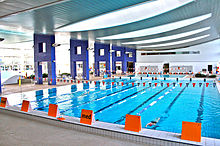
Indoor pools are located inside a building with a roof and are insulated by at least three walls. Built for year-round swimming or training, they are found in all climate types. Since the buildings around indoor pools are insulated, heat escapes much less, making it less expensive to heat indoor pools than outdoor pools (all of whose heat escapes).[33] Architecturally, an indoor pool may look like the rest of the building, but extra heating and ventilation and other engineering solutions are required to ensure comfortable humidity levels. In addition to drainage and automatic pool covers, there are a number of ways to remove humidity in the air that is present in any wet indoor environment. Efficient dehumidification in the indoor pool environment prevents structural damage, lowers energy costs for cooling or heating, and improves the indoor climate to provide a comfortable swimming environment.
Some colleges, universities, and high schools have buildings that use the term "natatorium" in their names, especially when the building houses more than just a swimming pool, for example a diving well or facilities for water polo. The word natatorium was borrowed from Late Latin "place for swimming" into English in New England in 1890.[34][35]
Suspended swimming pool
This type of swimming pool is suspended high above the ground. A prominent example is the Sky Pool in London's Embassy Gardens, the world's first floating pool.[36]
Other uses


Swimming pools are also used for events such as
Sanitation

Levels of bacteria and viruses in swimming pool water must be kept low to prevent the spread of diseases and pathogens. Bacteria, algae and insect larvae can enter the pool if water is not properly sanitized. Pumps, mechanical sand filters, and disinfectants are often used to sanitise the water.
Chemical disinfectants, such as
Covers
Swimming pool heating costs can be significantly reduced by using a pool cover. Use of a pool cover also can help reduce the amount of chemicals (chlorine, etc.) required by the pool. Outdoor pools gain heat from the sun, absorbing 75–85% of the solar energy striking the pool surface. Though a cover decreases the total amount of solar heat absorbed by the pool, the cover eliminates heat loss due to evaporation and reduces heat loss at night through its insulating properties. Most swimming pool heat loss is through evaporation.[39]
Winterization
In areas which reach freezing temperature, it is important to close a pool properly. This varies greatly between in-ground and above-ground pools. By taking steps to properly secure the pool, it lessens the likelihood that the superstructure will be damaged or compromised by freezing water.[40]
Closing vinyl and fibreglass pools
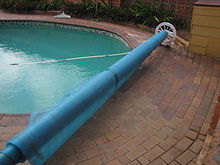
In preparation for freezing temperatures, an in-ground swimming pool's pipes must be emptied. An above-ground pool should also be closed, so that ice does not drag down the pool wall, collapsing its structure. The plumbing is sealed with air, typically with rubber plugs, to prevent cracking from freezing water. The pool is typically covered to prevent leaves and other debris from falling in. The cover is attached to the pool typically using a stretch cord, similar to a
In climates where there is no risk of freezing, closing down the pool for winter is not so important. Typically, the thermal cover is removed and stored. Winter sunlight can create an algae mess when a cover that has been left on all winter is removed. The pool is correctly pH-balanced and super-chlorinated. One part algaecide for every 50,000 parts of pool water should be added, and topped up each month. The pool should be filtered for one to two hours daily to keep the automated chlorination system active.[citation needed]
Safety

Pools pose a risk of
Diving in shallow areas of a pool may also lead to significant head and neck injuries; diving, especially head-first diving, should be done in the deepest point of the pool, minimally 2.4 m (7 ft 10 in), but desirably 3.7 m (12 ft), deeper if the distance between the water and the board is great.
Pools also present a risk of death due to drowning, particularly in young children. In regions where residential pools are common, drowning is a major cause of childhood death. As a precaution, many jurisdictions require that residential pools be enclosed with
Suspended ceilings in indoor swimming pools are safety-relevant components. The selection of materials under tension should be done with care. Especially the selection of unsuitable stainless steels can cause problems with stress corrosion cracking.[42]
Dress code
In public swimming pools, dress code may be stricter than on public beaches, and in indoor pools stricter than outdoor pools. For example, in countries where women can be topless on the beach, this is often not allowed in a swimming pool, and a swimsuit must be worn. For men, wearing ordinary shorts and a T-shirt to go in the water at a beach may be considered acceptable, but pools usually require real
See also
References
- ^ "Great Bath, Mohenjo-daro". harappa.com.
- S2CID 193579486.
- Britannica Online Encyclopedia. Archived from the originalon 13 October 2007.
- ^ "WWW Virtual Library: ANURADHAPURA". www.lankalibrary.com.
- ^ Kuttam Pokuna by Lanka Pradeepa, 3 November 2020, retrieved 8 July 2022.
- ^ "Lidos: Links and References". Archived from the original on 23 February 2015. Retrieved 19 April 2015.
- ^ "Historical Titbits". Maidstone Swimming Club. Archived from the original on 25 January 2012. Retrieved 26 October 2011.
- ^ The City of Oxford Swimming Club, History Archived 23 June 2018 at the Wayback Machine
- ^ "TGOL – Adriatic". Archived from the original on 11 June 2015.
- ISBN 978-0-7385-0466-7. Retrieved 15 November 2016.
- ^ "Yrjönkatu Swimming Hall". My Helsinki.
- ^ NZ Census, 7 March 2006.
- ^ "HistoricPlaces.ca – Recherche". Archived from the original on 24 February 2009.
- ^ Berlin, Jeremy. "Big Dipper: The World's Largest Pool". National Geographic Magazine blog central. Archived from the original on 15 January 2011. Retrieved 16 January 2011.
- ^ "World's Largest Swimming Pool". Guinness World Records. Archived from the original on 13 January 2008. Retrieved 24 January 2008.
- ^ Katzban, Nicholas (12 November 2018). "See the progress on the American Dream water park, now taking shape". NorthJersey.com. Retrieved 9 March 2019.
- ^ NASA, Behind the Scenes: Training. Retrieved 7 May 2007
- ^ "Deep Dive Dubai - The world's deepest pool". Deep Dive Dubai. Retrieved 2 August 2021.
- ^ Kaddoura, Mohamad (21 July 2021). "Explore the world's deepest diving pool that holds a sunken city". Guinness World Records. Retrieved 2 August 2021.
- ^ "Dive into the world's deepest swimming pool at 130ft". The Telegraph. Archived from the original on 23 September 2014.
- ^ "San Francisco Zoological Society – About the Zoo – Historic Sites". The San Francisco Zoo. Archived from the original on 9 January 2012. Retrieved 10 March 2008.
- ^ "Kąpielisko miejskie – Elbląg" (in Polish). MOSiR Elbląg. Archived from the original on 26 June 2010. Retrieved 13 November 2012.
- ^ "DESTRUCTION (1931–1990)". Archived from the original on 1 April 2015. Retrieved 19 April 2015.
- ISBN 978-7-5085-0374-5. Retrieved 30 November 2010.
- ^ Swimming 101 (13 September 2022). "How Big Is an Olympic-Sized Swimming Pool?". SwimSwam. Retrieved 12 October 2023.
{{cite web}}: CS1 maint: numeric names: authors list (link) - ^ Applebaum, Yoni (8 June 2015). "McKinney, Texas, and the Racial History of American Swimming Pools". The Atlantic. Retrieved 8 June 2015.
- ISSN 0362-4331. Retrieved 5 August 2022.
- ^ "Pool Safety Guidelines". Archived from the original on 25 September 2011. Retrieved 19 April 2015.
- ^ Federation Internationale de la Natation. Archived from the originalon 10 December 2015. Retrieved 30 January 2018.
- MIT. Retrieved 4 February 2007
- ^ "Stories from the Yamba ocean pool". ABC News. 1 December 2005. Archived from the original on 30 May 2006. Retrieved 28 December 2006.
- ^ Kurutz, Steven (5 April 2007). "From Europe, a No-Chlorine Backyard Pool". The New York Times. Retrieved 22 May 2009.
- ^ "Get Inspired: Swimming Pools: Types, Designs, and Styles". The Spruce. Retrieved 25 August 2017.
- ^ "The American Heritage Dictionary entry: Natatorium".
- ^ "Natatorium | Etymology, origin and meaning of natatorium by etymonline".
- ^ Cherner, Jessica (30 April 2021). "Suspended 115 Feet in the Air, the World's First Floating Pool Is Unveiled in London". Architectural Digest. Retrieved 19 April 2023.
- ^ sahatchaiw.com. "The theory of colors of water in the swimming pool" (PDF) by Sahatchai Wanawongsawad
- ^ .
- Hannah Devlin (1 March 2017). "How much pee is in our swimming pools? New urine test reveals the truth". The Guardian.
- ^ "Department of Energy: Conserving Energy and Heating your Swimming Pool with Solar Energy (PDF)" (PDF).
- ^ "Closing Your Pool". Archived from the original on 24 September 2011. Retrieved 19 April 2015.
- PMID 27035042.
- ^ M. Faller and P. Richner: "Material selection of safety-relevant components in indoor swimming pools", Materials and Corrosion 54 (2003) pp. 331–338. (only online in German (3.6 MB) Archived 27 March 2016 at the Wayback Machine) (ask for a copy of the English version)
- ^ "Thermal Pools". Visit Reykjavík – The official tourist website of Reykjavik. Archived from the original on 1 December 2010. Retrieved 24 December 2009.
External links
 Media related to Swimming pools at Wikimedia Commons
Media related to Swimming pools at Wikimedia Commons


